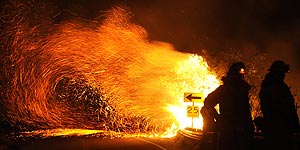
Since 1993 my wife and I have lived in Torrance California, just a half mile from the beautiful beach and the Pacific Ocean. We feel very fortunate to live here at the base of the gorgeous Palos Verdes Peninsula, but today we’re breathing a big sigh of relief learning that the Palos Verdes Wildfire was 100% contained this morning. What we’re not breathing is clean air, because the smoke from the La Canada-Flintridge fire, about 38 miles from here, is still making air quality hazardous and people in the L.A. basin are being advised not to spend too much time outdoors and to keep their doors and windows closed and their air conditioners running.
Our neighborhood is called the “Hollywood Riviera” because of its beautiful hillside homes with idyllic ocean views framed by palm trees. We’ve always planned on retiring and spending the rest of our lives right here, but these days we’re worried about what climate change is already doing – and about the far more serious consequences headed our way.
We’re already getting used to the fires, smoke and related air hazards here in the L.A. area where our annual wildfire season just keeps getting longer and longer.

Meanwhile our long term drought, now its its third year with no end in sight, means less available water to fight the fires with. It also means a Hobson’s choice over the most critical needs for this increasingly precious liquid resource.
And this summer it also means we’re experiencing mandatory water rationing that restricts our landscape watering to two days a week and forces other cutbacks in water use across the board.
My wife, Debra, is a horticulturist and works at our local South Coast Botanic Garden. In 2001 she terminated our grass lawns and replaced them with drought tolerant plants because of her concerns for water use. We both know that 20% of California’s electric power is used just to move water from the North down here to the South and all the other places it goes. So not only is climate change-driven drought cutting our fresh water supply, but the way we use water here also adds to our greenhouse gas emissions.
Because of our interest in horticulture we’ve also watched sadly as both native plants and our state’s legendary agriculture industry have already suffered the consequences of accelerating climate change and related climate conditions for growing. Things don’t grow well anymore in the places they have for generations.
We Californians are very proud of our state’s Global Warming Solutions law, AB 32, that mandates greenhouse gas emissions to be reduced to 1990 levels by the year 2020. That’s about a 25% reduction. By 2050 the law calls for us to reduce our emissions 80% below our 1990 levels. But we’re not experiencing the necessary sense of urgency that will make those emission reductions happen, especially not at the local level.

We’ve got a greenhouse gas-spewing Exxon-Mobil refinery just 5 miles from my house here in Torrance and 9 miles up Pacific Coast Highway sits the climate-changing Chevron refinery in El Segundo. We’re also only 12 miles from the Port of Los Angeles and the Port of Long Beach – the two largest stationary sources off air pollution and all their related greenhouse gases in L.A. County.
But as serious as climate change impacts already are here, we know from our state’s just released reports on Climate Change Adaptation Strategy that things will be getting worse no matter what we do. Just as we know that they’ll go from worse to catastrophically bad unless we act boldly and immediately.
Sea level rise, higher temperatures, more wildfires year-round, less water, fewer cold nights and devastating impacts to the people who grow half of the USA’s fruits, vegetables and nuts are just a few of the certainties in our future from unabated climate change.
Our Nobel laureate Secretary of Energy, fellow Californian, Dr. Steven Chu has already warned us “We’re looking at a scenario where there’s no more agriculture in California” unless the public wakes up and we take action now.
Because of our personal experiences and our knowledge of the overwhelming worldwide scientific consensus on climate change impacts, my wife and I have changed the way way we live and cut our own carbon footprint drastically. Among other things our electric use has been cut by over 50% in the last year.
I now devote my full time to working on environmental and energy issues. I’ve been blogging on the environment since October of 2007.
I volunteer with the South Bay Environmental Services Center doing community outreach and presentations. I volunteer with GRID Alternatives installing solar panels on low income and Habitat for Humanity houses. I volunteer with Greenpeace and the Environmental Priorities Network educating the public on climate change news and facts.
For the past two months I’ve been the Chairman of the South Bay Los Angeles 350 Climate Action Group. We’re taking part in Bill McKibben’s 350.org’s October 24 Day of International Climate Action. We hope to have thousands of people on the beach here in the South Bay forming the “Amazing Waving Human Tide Line” to demonstrate the projected impacts of sea level rise to our beloved beaches and coastal communities. You can find out more about it and how to join us at http://www.350.org/SouthBay350
I am driven to spend my time trying to wake people up and to working to make a difference because I took Dr. James Hansen, our nation’s top climatologist and Director of the NASA Goddard Institute for Space Studies, seriously when he told the US Congress on June 23, 2008:
“…we have used up all slack in the schedule for actions needed to defuse the global warming time bomb. The next president and Congress must define a course next year in which the United States exerts leadership commensurate with our responsibility for the present dangerous situation.
Otherwise it will become impractical to constrain atmospheric carbon dioxide, the greenhouse gas produced in burning fossil fuels, to a level that prevents the climate system from passing tipping points that lead to disastrous climate changes that spiral dynamically out of humanity’s control.”
2 PM PACIFIC TIME UPDATE FROM KPCC FM 89.3 PASADENA:
The Station Fire continues to spread in several directions, both north toward Acton and Agua Dulce, and to the west, burning near Sylmar and within a few miles of Santa Clarita. So far there are no evacuation orders for Sylmar or Santa Clarita. At least 21 homes have been destroyed, and more than 85,000 acres have burned. Fire officials now don’t expect full containment until September 15, a full week later than originally anticipated.
The fire is also progressing northeast, a mere half-mile from Mount Wilson, site of KPCC’s main transmitter. KPCC’s backup transmitter is up and ready to go, thanks to our public radio colleagues at KUSC, who have graciously enabled KPCC to add an antenna to their tower on Lookout Mountain. In the event our main transmitter goes down, we’ll be able to resume broadcasting in a matter of minutes. (KUOR in Redlands and KPCV in Coachella will be unaffected.)

